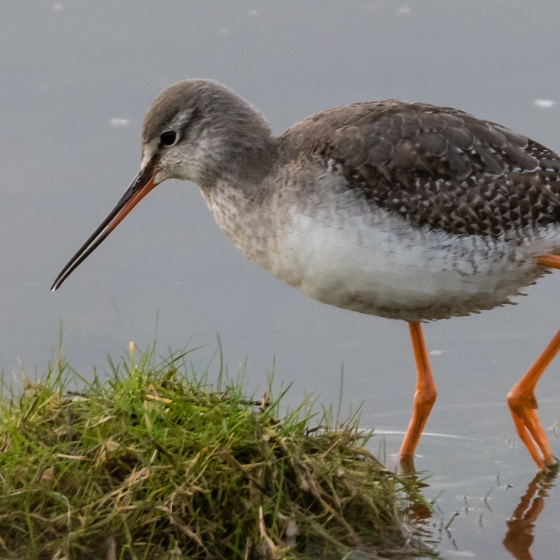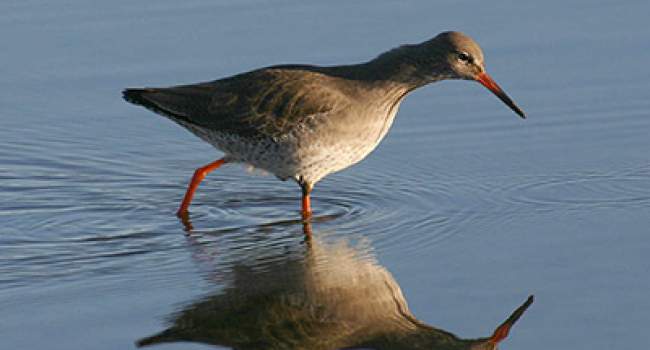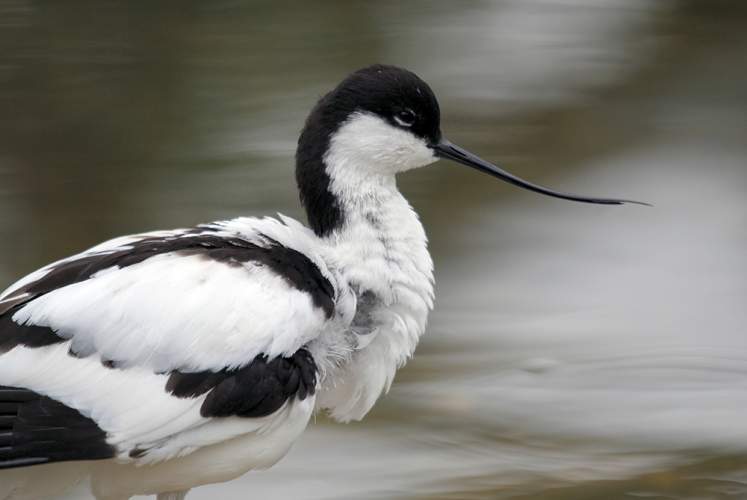Spotted Redshank
Tringa erythropus (Pallas, 1764)
DR
 SPORE
SPORE  5450
5450

Family: Charadriiformes > Scolopacidae

One of the most elegant waders, with its slim proportions and long needle-like bill, the Spotted Redshank lives up to its name when in its summer plumage, which is dark with white spots.
Spotted Redshank does not breed in Britain and is mainly a passage migrant, seen in both spring and autumn. Unlike the dark summer plumage, autumn and winter individuals are grey above and white below, much paler than their more uniform common cousin, the Redshank.
There is an increasing wintering population in England, with birds distributed mainly around the eastern and southern coasts. The Humber Estuary, The Wash and the Blackwater Estuary in Essex are favoured locations. Spotted Redshanks also winter in small numbers in southern Ireland.
Identification
Spotted Redshank identification is sometimes difficult. The following article may help when identifying Spotted Redshank.
Identifying common shanks

Redshank are common, familiar (and very noisy) waders found, year-round, on our coastal habitats as well as inland during the breeding season. Very small numbers of the related Greenshank breed, but can you separate Redshank, Greenshank and the arctic-breeding Spotted Redshank when all three can be found together in late summer and autumn on saltmarshes and lagoons?
SONGS AND CALLS
Listen to example recordings of the main vocalisations of Spotted Redshank, provided by xeno-canto contributors.
Call
Develop your bird ID skills with our training courses
Our interactive online courses are a great way to develop your bird identification skills, whether you're new to the hobby or a competent birder looking to hone your abilities.
Browse training coursesStatus and Trends
Population size and trends and patterns of distribution based on BTO surveys and atlases with data collected by BTO volunteers.
CONSERVATION STATUS
This species can be found on the following statutory and conservation listings and schedules.
DISTRIBUTION
Spotted Redshanks are most familiar as a passage migrant. Most winter in equatorial Africa, a small proportion remaining in western Europe, including up to 100 birds in Britain and tens of individuals in Ireland. Most occur around the coast in estuaries, marshes and coastal lagoons.
Occupied 10-km squares in UK
| No. occupied in winter | 195 |
| % occupied in winter | 6.5 |
European Distribution Map
DISTRIBUTION CHANGE
Spotted Redshank range has contracted in Ireland but expanded in Britain. The latter is consistent with a trend for increasing wintering by many waders, most likely linked to climate change.
| % change in range in winter (1981–84 to 2007–11) | +37.2% |
SEASONALITY
Spotted Redshanks are recorded throughout the year, though most often during early autumn passage. Small numbers winter.

Movement
Information about movement and migration based on online bird portals (e.g. BirdTrack), Ringing schemes and tracking studies.
RINGING RECOVERIES
View a summary of recoveries in the Online Ringing Report.
Foreign locations of birds ringed or recovered in Britain & Ireland

Biology
Lifecycle and body size information about Spotted Redshank, including statistics on nesting, eggs and lifespan based on BTO ringing and nest recording data.
SURVIVAL & LONGEVITY
View number ringed each year in the Online Ringing Report
Maximum Age from Ringing 
|
7 years 5 months 16 days (set in 1983) 
|
CODES & CLASSIFICATION
Ring size 
|
D |
Field Codes 
|
2-letter: DR | 5-letter code: SPORE | Euring: 5450 |
For information in another language (where available) click on a linked name
Research
Interpretation and scientific publications about Spotted Redshank from BTO scientists.
PUBLICATIONS (1)

Consequences of population change for local abundance and site occupancy of wintering waterbirds
Wavering Waterbirds
Protected sites are assigned based on population statistics for vulnerable and endangered species. This new study using WeBS data shows that changes in population size can affect local abundance, and thus influence whether or not key targets are met for site protection.
Would you like to search for another species?










Share this page